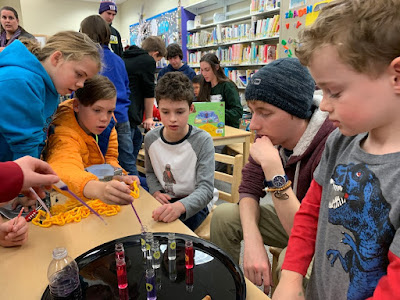The ways in which we bring science to the public have varied, but most often it has been work in our "service learning experience." Going out into the community (or sometimes even bringing the community to us) and participating in science related activities is a great way to spread knowledge and get people engaged.
Instead of just telling you readers about it, I'll give examples of some of the projects that I have personally been involved with.
~~~~~~~~~~~~~~~~~~~~~~~~~~~~~~~~~~~~~~~~~~~~~~~~~~~~~~~~~~~~~~~~~~~~~~~~~~~
Beginning with the start of the year, one of the first service learning experiences we had was having guest speaker Brian McHarg come in to teach us a little bit about how to engage with the public on an example topic of climate change.
We had to come up with different potential ways to engage with target audiences of different age groups.
It was actually a bit more challenging than I might've first expected, especially when thinking about how to engage with senior citizens.
One of the next things I was a part of was volunteer work experience.
Several classes of first grade students came to app to have a day of science related activities, and I had to manage several different stations throughout the day.
This example to the right was when I was helping the students look through microscopes to see their "geodes" (eggshells with colored crystals of salt and borax at the bottom).
A following project I was a part of was a community dinner that focused around sustainability.
A lot of people from the university and beyond came to have a completely waste free dinner with locally grown produce and compostable plates and utensils.
They also provided live music, played by university professors, which was really interesting to hear.
The next few projects focused back on elementary school students and participating in activities for them.
 |
| Here me and a classmate are setting up for a "treasure" game, where students have to solve clues to unlock the box to find what's inside. |
 |
| The students are all working on opening their locks |
 |
| Here me and another classmate are performing the same activity with a different group of kids. This time in a local library. |
 |
| It was a little different this time, as we used red cabbage juice to change the color of the liquid itself, rather than using pH strips to test acidity. It leads to the same results though. |
~~~~~~~~~~~~~~~~~~~~~~~~~~~~~~~~~~~~~~~~~~~~~~~~~~~~~~~~~~~~~~~~~~~~~~~~~~~
Overall the service learning experiences were fun for me. I had a good time with most of them, and I could tell they were enjoyable for most everyone else involved. In my opinion, they were a very good way of getting the public (especially younger kids) interested in and involved with science.






Great post Chandler! Definitely copy and paste the text and photos into your Google Site or whatever digital portfolio you want to use, it will be a great record of the volunteering work you've done and you can keep adding to it.
ReplyDelete